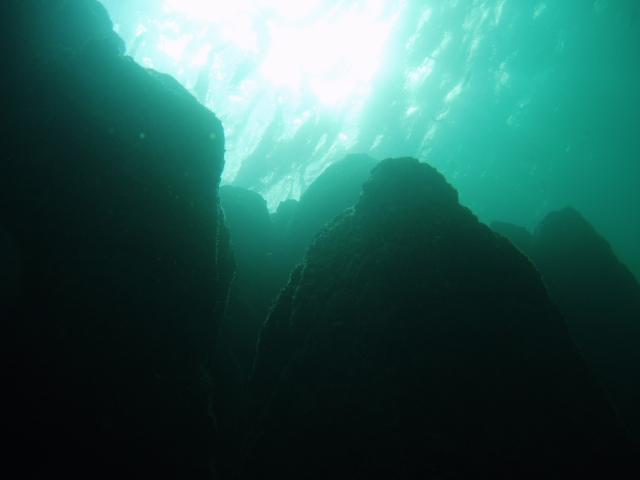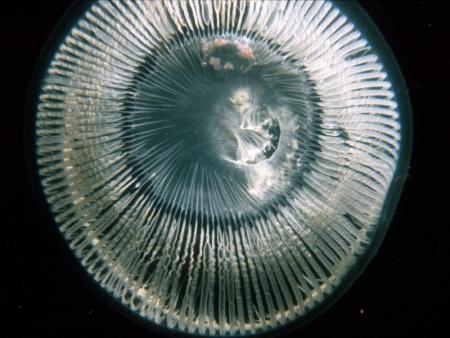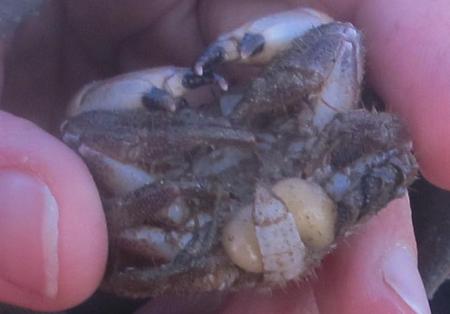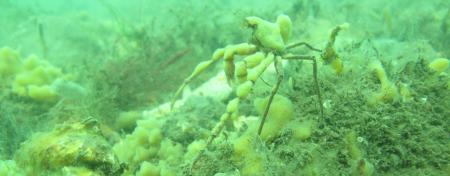Vanishing Seagrass Meadows
A talk presented by Barry Kaye (Lancashire MCS) March 2020. References and further reading are presented below the main talk.
Marine Plants

Most marine plants are microscopic ‘phytoplankton’. Of those that are large enough to see, the most common are ‘seaweeds’. These plants are adapted to live in shallow marine and intertidal areas where there is plently of light. Seawater provides the nutrients seaweeds need to live, so they just need to cling on to their preferred location, so they are not swept somewhere less hospitable: Where there is insufficient light or nutrients for them to compete with other species, or where they may be eaten faster than they can grow.
To do this they use a ‘holdfast’, which may appear root-like, but which works more in the manner of a hand, gripping a rock, rather than a root, which penetrates the soil.
Higher Plants

‘Higher’ plants have largely solved the problems of living on land. There is lots of light above ground, but the entire plant is not bathed in nutrients – these must be extracted from ground water through roots, which are buried away from the sun. Light absorbtion requires specialised leaves or fronds, held some distance above the ground to get the most light. The division of labours requires a sophisitcated transport (‘vascular’) network to bring together the requirements for photosynthesis, and spread its benefits to all parts of the plant.
These plants are not, however, well adapted to life in the sea – underwater there is less light than they are used to. Further, marine sediments are typically anoxic, so any part of the plant penetrating them must be supplied with oxygen to survive. As a consequence the roots would depend entirely on the exposed leaves for all of life’s essentials.
While roots do not help sustain the plant in a marine ecosystem, they can anchor it in soft sediments. This is an ecosystem that seaweeds cannot easily colonise, as their holdfasts have very little to grip onto, so cannot hold their position in anything other than the slightest currents. Some seaweeds have developed ingenious methods for reducing the strain on their holdfasts, such as springy bodies that absorb wave currents, rather than transmitting these stresses to the holdfast, which might become dislodged (see the ‘rubberiest plant on the planet‘ elsewhere on this blog, which provides insight into the complex internal structures displayed by some seaweeds – though these structures are rarely associated simply with transport of nutrients).
As a consequence, areas of shallow seas with soft sediments – sands or muds – can be successfully colonised by higher plants, with little competition from the otherwise well established seaweeds. The plants that have succeeded in doing this are called ‘seagrasses’. There a number of superficially similar species around the world, their forms being dictated by the rigours of the environment they have colonised.
Sheltered community

While seagrasses have been shaped by their environment, they also have an important role in shaping the environment in which they live. Seagrass shelters the water beneath its canopy, providing a refuge for juvenile fish, and stabilising the sediment for burrowers.
The blades of seagrass also exert a drag on the waves that pass over them. It has been calculated that substantial seagrass meadows can reduce wave height by as much as 50% on its trip from the open sea to the shore. (This is a very substantial reduction in wave energy, which is proportional to the square of the wave height).
In short, seagrass is as valuable as it is unlikely, supporting fisheries, and protecting coastal communities (and proterty). In the UK we only have one truly marine species of seagrass – Zostera maritima, which is shown in the photograph above. You can see some of the species that make it their home – two spot gobies, with a larger fish lurking in the background. The diversity of community is made clear when you compare the photo above to that below – taken of an adjacent patch of bare sand:

While seaweeds find it hard to establish on open sand, if there are no larger rocks to cling to, they have no problem colonising the seagrass itself. Often blades of seagrass are thickly tufted with fine filamentous algae – which are a serious problem, as they reduce the amount of light the seagrass gets. Fortunately, help is on hand from a range of small sea-snails, who are quite happy to eat the offending algae, providing a serendipitous cleaning service for the seagrass.
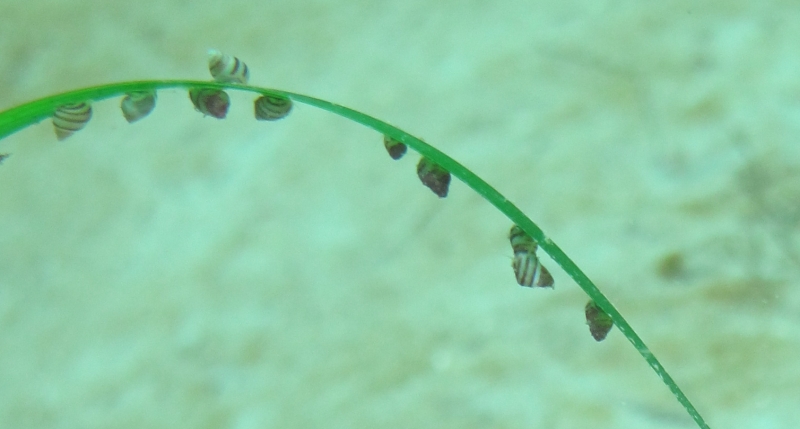
Algae and snails are not the only organisms to attach themselves to seagrass blades, and for some the presence of seagrass is essential for their survival. The critter below is a marine oddity – a stalked jellyfish. It belongs to a broader group that includes anemones and jellyfish. Indeed, this staked jellyfish is one that has given up its free floating existance and become tied to the seagrass. As a group the stalked jellyfish are characterised by their ‘stay at home’ nature. Not only have they given up a life of constant voyage, but they do not travel even as juveniles.

Disappearing meadows
As a home to stay-at-home species like the stalked jellyfish, you would think that seagrass meadows must be pretty stable places – stable enough that you don’t need to look for a new home very often at least! Indeed, seagrass meadows off the island of Ibiza in the Mediterranean have been estimated to be thousands of years old…
Sadly, the last century has shown that many seagrass meadows are in fact very fragile. It is estimated that approximately 90% of the area of seagrass meadows around the UK have been lost in the last century. The largest losses occurred in the 1930’s, but there has been limited or no recovery since.
Disease

Zostera maritima has been lost from all North Atlantic coastal regions. The principle cause of the loss has been put down to disease. The slime mould Labyrinthula zosterae, thought to be the culprit, colonises modern meadows, but generally without ill-effect. It seems that since the mass deaths of the 1930’s Zostera and Labarinthula have come to an uneasy truce. If the Zostera is stressed in any way, however, then Labarinthula gains the upper hand, and the plant will quickly die…
Stressed seagrass
Pollution: When we think about marine pollution, catastrophic oil spills grab the headlines, and so dominate our perceptions. Most Zostera beds are, however, relatively resistant to oil spills; paradoxically the oil-dispersant mixtures used to break the slick up and get it off our beaches, can be more damaging. Problems due to elevated nutrient levels from sewage and agricultural run-off, are insiduous, and very much harder to quantify and mitigate…
One result of elevated nutrient levels in seawater is the growth of algae – in the water column, and attached to the Zostera blades. Both of these reduce the light reaching the plants. Human activity can also effect the amount of light reaching the meadow, by suspending fine sediments in the water column through dredging, or bottom trawling.
A final insult to seagrass beds from human activity are the moorings of leisure craft. Typically these moorings have a length of chain running along the bottom that provides play to allow the boat to rise and fall with the tide. As the boat does so, and moves in response to wind and currents, however, the chain is dragged accross the sea bed, leaving cleared circles in the seagrass beds that can be seen from space…
Not all of seagrasses stress is from humans – prior to 1930, seagrass beds were the primary food source for Brent geese Branta bernicla. When the seagrass died, so did the geese. In fact the species was nearly extinguished by the tragedy, and only escaped extinction by broadening its diet to take sealettuce (a seaweed). Modern brent geese have further diversified to forage on coastal grasslands , resulting in a resurgence for the species.
Unfortunately Brent geese still have a liking for seagrass; but the seagrass meadows have not recovered. As a consequence a large flock of geese can cause considerable damage to any meadows in their environ.
Plans for recovery
Globally, seagrass meadows still have massive economic significance. They are a nursery for many commercial and subsitance fisheries, and have an important role in coastal protection. Often, however, their loss is most keenly felt by the poorest; those whose means of subsistence has been lost, who cannot afford sea defences, or to move as the sea sweeps in…
It was heartening, therefore, to read of a UK innitiative to try and reverse this trend of loss. Reported in the Guardian on the 10th March 2020, Project Seagrass has a global outlook, but most interestingly for me, is looking at re-seeding areas of former seagrass beds at Dale Bay in Pembrokshire. I wish them luck in their enterprise (and you can donate to their efforts through the link in the references section below!)
References – further reading
The drawings and photographs illustrating this piece are my own – I am not able to display some of the slides I used in the talk here for copyright reasons.
Estimates of the reduction in wave energy due to seagrass beds can be found in: Effect of a seagrass (Posidonia oceanica) meadow on wave propagation by E. Infantes, A. Orfila, G. Simarro, J. Terrados, M. Luhar and H. Nepf. in Mar Ecol Prog Ser 456: 63– 72, 2012. https://doi.org/10.3354/meps09754
A study on the diversity and stability of seagrass meadows can be found in Long-term persistence of structured habitats: seagrass meadows as enduring hotspots of biodiversity and faunal stability by A. Challen Hyman, Thomas K. Frazer, Charles A. Jacoby, Jessica R. Frost and Michał Kowalewski. Proc Roy Soc B Published:02 October 2019 https://doi.org/10.1098/rspb.2019.1861
Stalked jellyfish are not a common find underwater, you can find out more about their lifestyle at STAUROMEDUSAE / STAUROZOA. The identity of species photographed was established with the assistance of of the Stauromedusae UK website, I had previously mis-identified it as H. auricula, which is found in guide books, though apparently a rather rare…
The seagrass meadows off Ibiza are composed of Posidonia oceanica, and lay a claim to be home to the oldest plants on the planet. Cloned individuals have been estimated to be 100,000 years old. Sadly they are under threat – for more information see Ibiza and Formentera Preservation (Posidonia).
The loss of Seagrass meadows around the British Isles is catalogued by the Botanical Society of Britain and Ireland. You can see maps showing the declining distribution at BSBI Maps.
The factors causing problems for British seagrass beds have been documented in ZOSTERA BIOTOPES An overview of dynamics and sensitivity characteristics for conservation management of marine SACs by D.M. Davison and D.J. Hughes. Scottish Association for Marine Science, which is available in online.
You can see the circles cut in the seagrass in the satellite view of Studland Bay on Google maps.
Efforts to re-seed former meadows were reported in the Guardian on the 10th March 2020. The scheme is an initiative of the Project Seagrass charity.







